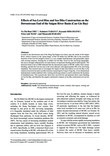Located at the downstream end of the Dong Nai-Saigon river basin, near the mouth of the Saigon River, which is known as the “green lungs” of Ho Chi Minh City (HCMC) due to the ecosystem functions of the Can Gio mangrove forest, is a very complex hydrodynamic and geomorphic region with crossing estuaries, forming the so-called Can Gio Bay. Given its flat, low-lying topography, this area is strongly influenced by two main factors: (1) upstream flooding and (2) tidal regimes. The historical flood event of 2000 indicated that the downstream region of HCMC suffers from serious flooding, and that the Can Gio area is the worst affected, with approximately 90% of its area being inundated. This research aims to investigate the impact of tides and inflows in Can Gio Bay in the context of sea level rise and a sea dike structure connecting Go Cong to Vung Tau. A two-dimensional hydrodynamic model combined with a wetting and drying scheme is used to determine the locations of inundated areas. This research also shows how sea level rise and upstream flows cause flooding in Can Gio Bay, and identifies the negative and positive impacts of sea dike construction on Can Gio Bay.

